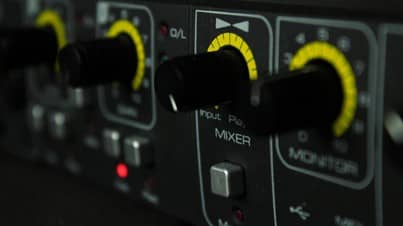A professional interface is a foundation for achieving a professional sound when recording instruments: guitar, bass, keys, and vocals for your tracks.
The interface needs to provide a clear and transparent signal without any latency coming through your DAW.

This helps to record instruments with the smallest amount of gain with a good signal to noise ratio, which provides adequate headroom for post mixing which assists in producing the best final product with your tracks.
Which Interface is Best?
With so many different audio interfaces on the market today, for a beginner, it’s easy to think that the devices with a higher price tag mean better recording quality than the cheaper devices!
However, this isn’t the case, as most entry-level devices offer near enough the same recording quality as most higher spec devices.
The only thing separating the cheap and expensive interfaces is additional inputs, higher sample rates and the connectivity type such as Firewire and Thunderbolt for recording with ultra-low latency.
What Determines an Audio Interfaces Capturing Quality?
Keep in mind, there are many things influencing the capturing quality of a device but the main factor that determines the recording quality of an audio interface/external sound card is the quality of the preamps.
For all of you that are unaware, a preamp is a built-in component within the interface that receives your instrument’s signal, whether from a microphone or guitar pickup and (as the name suggests) amplifies it to line level for recording and manipulation within your DAW.
The goal with good a preamp is to amplify a signal without adding any unwanted ‘noise’ or artifacts. The good news is most entry-level audio interfaces nowadays have excellent preamps that easily capture a clear and transparent signal for accurate recordings within a DAW.
Should I use an External Preamp?
More advanced recording enthusiasts may use an outboard preamp device. Not because their audio interfaces stock pres are bad in any way. The only problem is that an audio interfaces pres sound is too clean and transparent and lack character.
External preamps are therefore favored as they are known for offering sonic warmth and tonal character which is important in the modern world of digital recording.
It’s used in the same way a guitarist will use different pedals and amps to add character and color their sound. Either way, there’s nothing wrong with recording on stock or external pres, the choice will ultimately come down to personal preference.
Other Factors that Influence an Interfaces Recording Quality?
The A/D (Analogue to Digital) Converters
The A/D converter is a component within the interface that converts the analogue signal from your instrument to a digital signal. Put simply, when an A/D converter digitizes a signal, it is sampled then quantized.
However, the quantization process adds unnecessary noise to the signal which sounds like a white noise or a quiet hiss. When recording a digital signal, the goal is to eliminate as much as noise as possible while having a strong signal for recording.
The Bit Depth
It is worth mentioning that the bit depth translates to the quality and representation of a digital sound. Meaning the higher the bit depth, the more accurate the digital signal will be interpreted from the analogue signal.
24 bit is the standard that most recording devices achieve with other devices recording as high as 32 bit, but this is overkill in my opinion.
Some older devices record at 16 bit, so before purchasing an interface check that the device supports at least 24 bit which is the standard for most professional sound cards.
The Sample Rate
Some brands like to market and advertise interfaces with a hook that is ‘sample rate’. Without getting too technical, the sample rate is measured in Kilohertz (kHz) which translates to how many times a digital signal is sampled.
You can think of sample rate as the audio version of ‘frames per second’ when capturing video. The higher the sample rate, the more snapshots are taken of the audio signal every second.
The lower the sample rate, the fewer snapshots are taken less of the signal. The ‘snapshots’ represent data, meaning the higher the sample rate, the more audio data is captured from the signal.
Related Post
As a side note, you must read my next post ”Audio Interface vs DI Box‘ Learn the Key differences between both audio capturing devices
Is a High Sample Rate important for Recording?
A complete beginner to digital audio would believe that when recording, a higher sample rate means more data captured resulting in higher quality of audio captured?
Not necessarily! Because humans can only hear frequencies at around 20 kHz, there’s no noticeable difference recording any higher than 96 kHz.
This is why all audio in the past (CD’S MP3,) have all been recorded at 44.1 kHz because going any higher will not produce any better results.
There’s a big debate between sound engineers and audio industry experts on this topic, but to put this into perspective here are some common sample rates.
- 20 kHz – Human adult audible limits
- 44.1kHz – CD, mp3, audio (standard for digital recording)
- 48.1 kHz – Movies and films
When choosing an audio recording device for home recording, sample rate will be a factor low on the list, but It’s useful to know what it means and for peace of mind that you are not missing out on anything major.
It’s worth mentioning that some plugins will not work above 96 kHz. If I was to recommend some specifications, it would be this, purchase an audio interface with a minimum bit depth of 24 and a minimum sample rate of 44.1 kHz.

How to Test your Interfaces Capturing Quality?
To test the quality of your preamps when recording direct, you should listen to the raw bypassed signal through the PC monitors, listening to the volume and clarity of the signal.
The sound that you want to hear is almost like a clean guitar tone that has clarity, definition and color without being too dry, which indicates a good quality preamp.
I have tried cheap, low-end interfaces in the past and noticed the signal sounding muddy and dry indicating low quality. A solution was to turn the gain up on the device. However, the signal would become too hot and close to clipping with little headroom to work with which is not ideal for post-production.
For this reason, you should never connect an instrument into a PC sound card if you desire high quality sound, the main reason being that PC sound card preamps are not fit for purpose with instruments.
Furthermore, a PC soundcard cannot guarantee clear and transparent recordings with low latency. If you have not invested in an interface yet, I have an in-depth article reviewing the best budget audio interfaces I recommend here.
Hooking up your guitar pedals to an audio interface can bring problems. Hence, why I created this post to give you the fundamentals. You can read this post here!
What about USB, FireWire and Thunderbolt Interfaces?
When it comes to choosing an audio recording device, there will be three types on the market known as: USB, FireWire and Thunderbolt.
Essentially, all 3 types still serve the same purpose which is to convert an analogue signal from your instruments to a digital signal for your PC. The recording or capturing quality is more or less the same despite the variance in price. So what’s the difference?
The main difference is the data transfer rate or ‘speed’ that data can be transferred from one device to another. So, in a nutshell, how fast the interface can process and transfer the signal data to your PC. So why would you need an audio interface with fast data transfer rates?
The reason is ‘latency’. When Latency is present, recording and playing an instrument through PC becomes a big issue. Using the guitar as an example, latency translates into a delay in the time you strike the strings and hearing back the signal which is impossible for playing and recording.
Luckily USB devices have enough speed for the exclusion of any latency within a signal chain.
The reason why producers will upgrade to a Thunderbolt device would be for big projects using multiple recordings with the inclusion of many data heavy plugins and VSTs. This will will require a powerful device that can quickly transfer large amounts of audio data to and from the PC.
Conclusion
With all this information in mind, It is important to know that the final product of a project can be influenced by the sum of the parts. These include cables, microphones, monitors, instruments, mixing hardware, DAW, recording techniques, additional software, plug-ins, effects, mixing environment etc.
All these small differences add up to a noticeable difference in sound quality, but having a professional interface is the foundation for professional recording quality.
